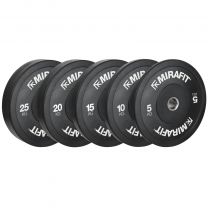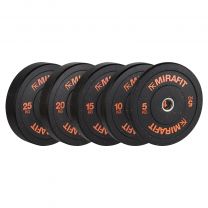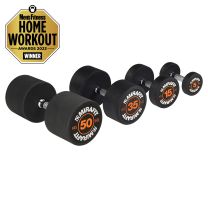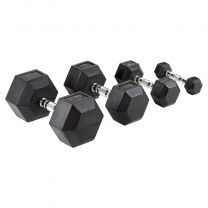Dumbbells Vs Barbells: Which Is Best For Muscle Growth?
Dumbbells Vs Barbells: Which Is Best For Muscle Growth?
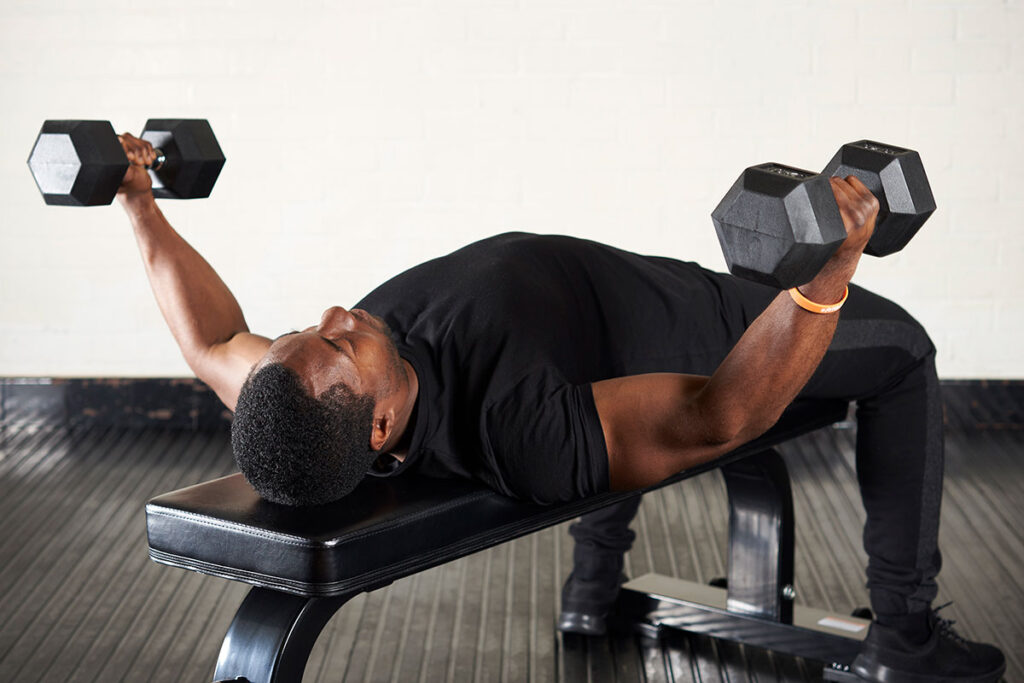
When it comes to getting the most out of your strength training, free weights are always going to come top.
However, there are lots of ways you can train the same muscle groups. And any serious weightlifter is going to want to know the best route for maximising gains. For example, are barbell rows the same as dumbbell rows? Or do they have different benefits? What about dumbbell shoulder presses? Are they better than barbell overhead presses?
Below we go through the benefits of using dumbbells and barbells to help you get the most out of your workouts.
Benefits of dumbbell exercises
Dumbbells are most commonly used for isolation exercises and are great for upper body work as well as exercises such as lunges, walks and carries.
So, let’s look at them in more detail
Weight load
To build muscle, you need to be performing heavy compound movements. Because dumbbells aren’t as easy to use as barbells, they require greater stability. And with the extra focus, energy and activation going into managing your movements, you won’t be able to reach the same weight loads when using dumbbells.
Ease of use
Using dumbbells gives you a little more flexibility in terms of choosing the angles that you train at. This can be great for anyone who struggles with joint mobility as you can maintain a more neutral grip. Dumbbells allow you to move more naturally, which is not only more comfortable but will also optimise your workouts.
Dumbbells do take a lot of practice, however, and getting set up right can be more difficult. When performing deadlifts for example, the grips are lower down than if you were using a barbell. Squats, too, require much more stability when using dumbbells.
Working to overcome these challenges is all part of targeting weak links and will benefit you in the long run.
Muscle imbalances
Dumbbells are perfect for isolation work. And because you’re using your arms independently, there’s no risk of your stronger side carrying the weaker side. This is beneficial for anyone wanting to keep an eye on any imbalances they have.
The longer that imbalances are left without being addressed, the more likely you’ll create asymmetries which can put you at risk of injury.
Another problem with having one side that’s weaker than the other is that you’re less likely to be able to push past your one-rep max. So, dumbbells can help you stay on track with your strength training.
Stability while exercising
Dumbbells can be a little trickier to use than barbells. This is simply due to the fact that you have a greater range of movement when using dumbbells. So, you don’t quite have the same level of stability that you can get with a barbell.
However, more often than not, a higher level of difficulty can prove more advantageous. To progress and build strength, you need to challenge your weak spots. And the only way you’re going to do this is by getting out of your comfort zone and training in a way that develops you in more ways than one.
Training efficiency
Dumbbells are much quicker to change over than loading and unloading a barbell. So, in terms of getting in more reps, dumbbells can be really advantageous.
You can also vary the exercises you’re doing without putting the weights down and this is ideal for greater muscle activation.
Home gym compatibility

Dumbbells don’t take up much space and you don’t need a Squat Rack or a Power Rack to use them. So, if you’re looking to get a decent strength workout in at home, then dumbbells are a great way to train.
Benefits of barbell exercises

Barbells are two-handed weight bars and are used for heavy lifts such as squats and deadlifts. They can also be used for curls and presses and are most commonly used alongside a power or a squat rack.
The term ‘barbell’ refers to a range of weight bars including EZ curl bars, Swiss bars and trap bars. Here we’ll just be discussing the traditional, straight 7ft Olympic barbell.
Weight load
Barbells are, in general, able to hold a greater amount of weight. They’re also used for the heavier lifts in the gym such as squats and deadlifts.
They’re also slightly easier to use in terms of stabilisation and for that reason, you can afford to add on even more weight.
Barbells are usually placed on a rack so it’s easier to get into position for training. This also helps you to increase the weight for progressive overloading.
Ease of use
Although barbells are extremely versatile, there isn’t quite the same amount of freedom of movement when using a two-handed weight bar as opposed to using dumbbells.
And because you’re slightly more restricted, this can make them easier to use. For example, when performing squats, you have the bar supported on your back as well as bar rests and safety bars should you need them.
Olympic barbells are more cumbersome, however. And getting your hands into the right position can put pressure on your shoulders, elbows and wrists. So, comfort and general stability using the bar can sometimes be an issue.
Muscle imbalances
Barbells won’t isolate a particular side. So, if you have one side that’s stronger than the other, you can potentially end up with imbalances.
The way to work around this is to use dumbbells to supplement your heavy lifts, so that you can keep a check on your weaker areas.
Stability while exercising
Training inside a power rack is optimal for heavy lifting. The bar is in position, the spotter bars add safety and you’re usually performing one straight movement at a time.
This sort of training is great for powerlifters or anyone simply looking to build pure strength and muscle mass.
Training outside the rack can be trickier. So, performing Olympic weightlifting moves, is more difficult.
Also, doing exercises such as the overhead press with a barbell can feel more awkward on your wrists than when using dumbbells.
Overall, barbells do feel more stable when training, which is perfect for handling more weight. You can, however, miss out on the opportunity to target your stabilising muscles at the same time.
Training efficiency
Barbells take time to load and unload. So, getting your rack set up can add extra time to your training. You also need more time in-between sets when performing heavier lifts. This is because your muscles need more time to recover.
However, this style of training is essential for building strength and muscle mass.
Barbells are also great for performing accessory lifts such as partial deadlifts, half squats and pause squats. These are again, all essential for building strength. So, although you might not be varying the types of exercises you’re doing – in comparison to using dumbbells – you can still vary your training style.
Home gym compatibility
Having your own garage gym is a dream for many. And if you’re serious about building muscle, then having a power rack and barbell set up is a must.
If you don’t have the space however, there are other options such as half power racks, 6ft international weight bars and shorter barbells. So, all is not lost.
Do I have to lift heavy to build muscle?

Building strength as well as muscle requires progressive overload. So, whatever stage you’re at, you’re going to need to keep upping the weight if you want to improve.
The term ‘heavy’ is also a tricky one as it refers to whatever is heavy for you. Whether it's 5kg dumbbells, or 40kg dumbbells, we're all different and should train at a weight that's right for us.
So, rather than thinking about it in terms of weight loads, you need to be looking at it from a reps and sets point of view.
For building strength, you ideally want to be working to a rep-max of between 1-6 reps. This means reaching failure at your chosen amount of reps rather than just stopping at that point.
For increasing muscle mass, you want to be working within a rep range of 8-12. Again, this means failing at your chosen number of reps within the 8-12 range.
What these actual weight loads are is dependent on you and your current ability.
Additionally, it’s most likely that you will want to do both styles of training so that you can fully benefit as well as progress.
Do dumbbells help build muscle?

Dumbbells can definitely help you build muscle. And they’re also great for giving you a better picture of where your physical strengths and weaknesses lie.
They help to avoid imbalances as well as target specific areas. So, for example, if you want to focus smaller muscle sets such as the brachioradialis, dumbbells are much more suitable than barbells.
As mentioned above however, you need to keep an eye on your reps and sets to ensure you reach your goals.
Dumbbells vs barbells: which is best?

Using both barbells and dumbbells is the most beneficial way to train in terms of muscle growth as well as building strength. However, there are ways you can employ each type of weight to make sure you get the most out of them.
Barbells enable you to progressively overload more effectively and are typically better for your heavy lifts - so for sets of 1-6 reps.
Dumbbells are better for accessory lifts, endurance style training and muscle building. So, use them for sets of 8-12 reps or more.
For more content, follow us on Instagram, YouTube, TikTok, and on our official Mirafit Facebook page.
Enter your email to signup to our newsletter
Tags: Equipment > Bars & weight Plates ; Equipment > Dumbbells ; Exercise Type > Strength ; Misc > Gym Planning

